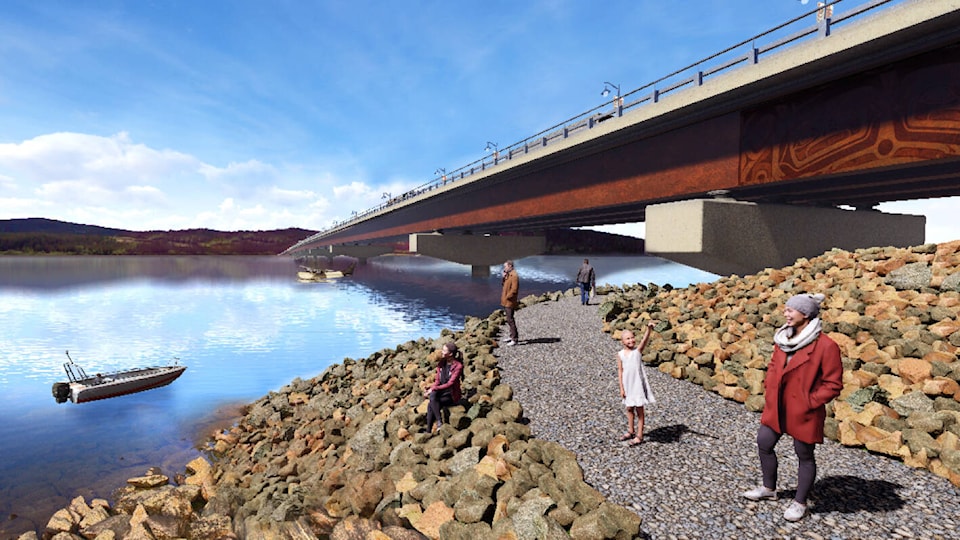The replacement of the Nisutlin Bay Bridge in Teslin is being dubbed the “largest capital project in Yukon history” by the territorial government.
It is turning into a $160-million excursion, according to the Yukon government’s May 5 news release.
Graham Infrastructure LP has been awarded the project for $135 million more than the former minister of Highways and Public Works mentioned three years ago.
In a May 6 release, the Yukon Party calls it a “staggering” difference from when now-Minister of Community Services Richard Mostyn told members of the Yukon Legislative Assembly on April 30, 2019 the price tag is “somewhat north” of $25 million.
“This raises the question if the Liberals had actually accounted for inflation, why have they gone so massively over budget on this project just two months after the tabling of an almost $2-billion budget and how does this impact other projects moving forward?” reads the official opposition’s release.
The Yukon government’s five-year capital plan for 2022-23 identifies $75 million to $87 million for the bridge, which is more than the total amount of money being put toward replacing or rehabilitating a number of other bridges across the territory.
Krysten Johnson, a communications manager in the Highways and Public Works department, explained the discrepancy and the increased cost.
“Although the bids came in higher than anticipated, awarding the Nisutlin Bay Bridge project was a high priority project for our government as it will provide a significant positive economic outcome for the territory, First Nations, local businesses and the community of Teslin,” Johnson said in an email.
The old 2019 capital plan only listed $25 million and up as the highest price bracket, Johnson said, while the most recent plan includes a more detailed estimate that fell far below the actual bid.
“This bridge is a very important piece of infrastructure for the Yukon and the Yukon’s economy, as it serves as a critical transportation link for the territory and keeps us connected to the rest of the country. Prior to awarding the contract, we first considered all options to ensure we were making the right decision on behalf of Yukoners,” reads Johnson’s email.
The Yukon Environmental and Socio-economic Assessment Board registry states the bridge will be located at kilometre 1,243 along the Alaska Highway, about 20 metres upstream from the existing bridge over Teslin Lake.
Johnson reasoned that prices came in higher than expected due to “current global circumstances and the high premium on steel and other materials” in the email.
“It is clear that these prices are likely to be elevated for years to come. Awarding now, before prices increase further, was a contributing factor in our decision,” Johnson said, citing recent flooding in B.C.’s Fraser Valley and higher infrastructure spending across North America.
“In addition, even though this contract closed before the war in Ukraine, that crisis will directly affect the production and cost increases related to reinforcing steel, as Ukraine is the provider of raw billets to produce reinforcing steel. The sanctions in Russia have also caused a surge in fuel prices and an increased cost in base materials.”
The government release states the Yukon government and the Teslin Tlingit Council signed a project charter in 2019.
The release states council and the community gave input on the design.
In a question and answer document on the project, the Yukon government said it is working with the self-governing First Nation to make cultural elements, design and artwork for the bridge.
The document states the original bridge was built in 1953, while the average lifespan of a bridge in the territory is 75 years.
The document indicates routine repairs and maintenance are not enough to keep the bridge safe in the long term. It lists concerns about high water, earthquake activity and more traffic.
On the website, it reads that the new bridge will make it safer for pedestrians and cyclists to cross and allow for more traffic.
The new 483-metre-long paved bridge will have two lanes for vehicles, including heavy and overweight truck traffic, a wide shoulder for bikes, a lit up pathway on the bridge for foot and wheelchair traffic and another pathway under the bridge for pedestrians and snowmobiles.
Between 20 and 45 workers will be living in a construction camp near Teslin, according to the document.
The government website states the contractor must hire local contractors “whenever possible.”
The old bridge will be decommissioned once the new one is ready, according to the department.
Construction on the new bridge will begin “soon” and it should be ready by 2026, Johnson said.
Contact Dana Hatherly at dana.hatherly@yukon-news.com
